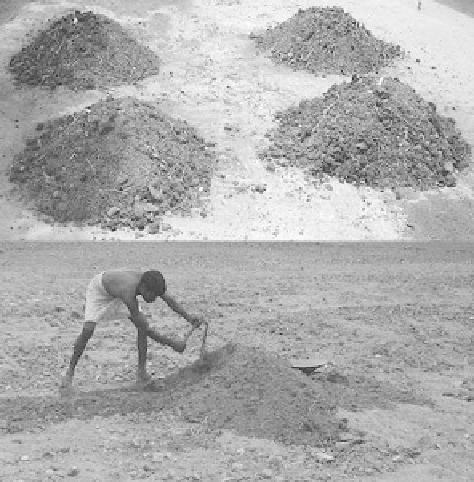Agriculture Reference
In-Depth Information
FIGURE 13.2
FYM application in the fields. (Reprinted from CRIDA. With permission.)
and postemergence diseases. On average, well-decomposed FYM contains 0.5% N,
0.2% P
2
O
5
,
and 0.5% K
2
O (Reddy 2011). There are two types of FYM, the first made
in the rainy season and the second made in winter. Farmers recognize the second
type of manure as the best for crops due to its well-decomposed nature. Farmers in
India always attempted to use manure as an alternative for chemical fertilizer. But
with the increase in population, more and more dung is used as fuel cakes for cook-
ing. Particularly in northern India, shrinking animal population due to mechaniza-
tion and labor shortage to transport manure to far-flung fields have all led to rapid
decline of this practice. Applying green leaf and FYM is the traditional method of
improving the condition of the soil, in which green leaves and FYM are plowed into
the soil. It helps in improving soil fertility through nitrogen fixation (Sarma 2002;
Talukdar et al. 2002; Satapathy 2002; Laxminarayana 2002; Tiwari et al. 2002;
Bregman 1993).
13.3.3 F
allowinG
The indigenous method of restoring the soil fertility is fallowing. Traditionally,
farmers observed that yields on poor land (
Kiyari
soils) decline if they continuously
grow two or three crops a year under irrigated conditions without any fallow period.
The fallow period varies from soil to soil. The
Kiyari
soil type is kept fallow for
1 year, while
Bangar
and
Karail
are kept fallow for one season. In general, farmers
adopt two methods of fallowing. In the first method, land is kept fallow after taking
the paddy in the
Kiyari
soil for over 1 year, and timely plowing is done after every

Search WWH ::

Custom Search